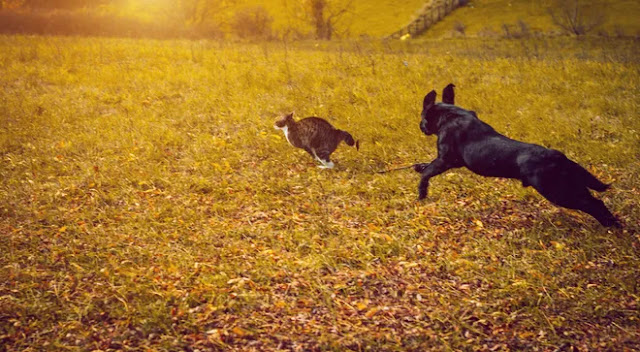When a dog chases a cat, a person, a car, or anything else it sees, this page provides resources to help you stop the behaviour. It's not brain surgery to figure out that a dog's natural instinct is to chase after moving targets.
Despite being an instinct for your pet, this behaviour can be detrimental when directed at the mailman or a jogging neighbour.
You should start immediately working on preventing your dog from chasing moving objects. The best time to start training your dog is when it is still a young puppy.
If this isn't implemented at the right moment, you and anybody your dog tries to chase could be in danger since some breeds grow to be quite huge and vicious. As a result, you should start teaching your puppy as soon as possible, before he or she grows too big for you to manage.
+++++++++++++++++++++++++++++++++++++++++++
If you want the
complete solution to having an amazingly well behaved dog…
You should checkout my
brain training for dogs course… Click here for details…
+++++++++++++++++++++++++++++++++++++++++++
It's common knowledge that some breeds of dog are more amenable to being trained than others. Certain breeds of dog, such as hunting dogs and farm dogs, are hardwired to chase.
Your pet should remain on a leash until you have established some level of control over the chasing behaviour. When taking them outside in public, you must continue to keep them on a leash even after they reach the point of control.
You should take the necessary precautions to start your dog's training to halt dog chasing in a controlled environment like a yard with a robust fence before taking him or her out into the world.
In this way, your pet will be able to focus entirely on you and the training you've prepared for him or her. The goal is to establish a routine, and you should do so in the confines of the regulated environment at your disposal.
Better yet, begin your training sessions inside before moving them outside into the yard. Establishing the necessity of the leash's use from the get-go requires that you always have it on your dog, even when inside the house. Put your puppy at one end of a room and yourself at the other.
You then approach your dog while holding a ball and preventing the dog from making any touch with you. It's time for the test.
Roll or bounce the ball and work on your "stay" command with your dog. Now, if your dog starts after the ball, give him a firm yank on his leash and give him the "stop" command as many times as necessary.
Never let your dog contact the thing you are using when teaching it not to chase cats, cars, etc. Your pet will require as many repetitions of this method as it takes to learn the command.
Read more about brain training for dogs in this article… click here
When your pet finally gets it and doesn't try to paw at the ball anymore, be sure to praise and treat him or her like you would for any other accomplishment. Read also: Treatment and Prevention of Dog Separation Anxiety
Once it appears that your training efforts have been successful, you should relocate to a new area of the house. Once you've accomplished what you set out to do inside the house, it's time to transfer training to an outdoor area with a fence.
Even if you know you're not meant to let your puppy chase things, it may take some time for them to internalise that fact.
To put it through its paces, have a friend, if they're game, act as a runner while you apply the same methods you did to the other training areas. Read also: Understanding Your Dog's Emotions for a Better Bathing Experience
Don't forget to show appreciation for a job well done; doing so will build trust that the person will continue to meet your expectations.
Your dog will soon become the obedient companion you've always hoped for after you teach him to stop chasing cats, cars, joggers, and anything else that moves. Being patient is the most important quality you can have as a dog trainer.


